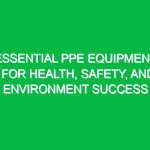Welcome, team! Today, we are here to discuss an essential topic that plays a crucial role in our Health, Safety, and Environment (HSE) practices: Glycol Reclamation. This Toolbox Talk aims to equip you with the knowledge and best practices necessary to maximize safety and efficiency in our operations. Let’s dive into the world of Glycol Reclamation and understand its significance in our daily work.
The Importance of Glycol Reclamation
Glycol Reclamation is a critical process that involves recovering and reusing glycol-based fluids used in various industrial applications. By reclaiming glycol, we not only reduce waste and environmental impact but also ensure the safety and efficiency of our operations. Proper Glycol Reclamation helps us maintain a sustainable and responsible approach to our work, aligning with our commitment to HSE principles.
The Process of Glycol Reclamation
When it comes to Glycol Reclamation, it’s essential to understand the process involved. By recovering used glycol, we can purify it through filtration and distillation, making it suitable for reuse. This process not only conserves resources but also minimizes the risk of contamination and potential hazards in our operations.
Potential Hazards and Risks
While Glycol Reclamation offers numerous benefits, it’s crucial to be aware of potential hazards and risks associated with the process. These may include exposure to harmful chemicals, equipment malfunctions, or improper handling of reclaimed glycol. By following proper procedures and safety guidelines, we can mitigate these risks and ensure a safe working environment.
Best Practices for Glycol Reclamation
Now, let’s discuss some best practices to optimize our Glycol Reclamation processes:
- Regular Maintenance: Ensure that equipment used for Glycol Reclamation is properly maintained and inspected to prevent any malfunctions or leaks.
- Proper Handling: Follow guidelines for handling reclaimed glycol safely, including wearing appropriate personal protective equipment (PPE) and avoiding direct contact with the substance.
- Training and Education: Provide adequate training to employees involved in the Glycol Reclamation process to ensure they understand the procedures and safety protocols.
- Waste Management: Implement proper waste management practices to dispose of any by-products or waste generated during the reclamation process responsibly.
Compliance and Regulations
It’s essential to comply with relevant regulations and standards governing Glycol Reclamation. By adhering to these guidelines, we not only ensure the safety of our employees but also fulfill our legal obligations. Compliance is key to maintaining a safe and sustainable working environment for all.
Conclusion
In conclusion, Glycol Reclamation is a vital aspect of our HSE practices that contributes to safety, efficiency, and environmental responsibility. By understanding the process, following best practices, and complying with regulations, we can maximize the benefits of Glycol Reclamation in our daily operations. Thank you for your attention and dedication to safety. Let’s continue working together to uphold the highest standards of HSE in our workplace.


